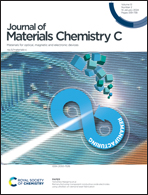Characterization of ultrathin nanoporous gold films for improving the performance of SPR biochemical sensors†
Abstract
This work reports on the preparation and biochemical sensing application of an ultrathin nanoporous gold (UTNPG) film. Large-area UTNPG films with a thickness of less than 15 nm were prepared on the conventional Au-SPR chips using a sputtering-dealloying combined method. The scanning electron microscope images of the as-prepared UTNPG films show a two-dimensional irregular porous morphology. Using a laboratory-made Kretschmann-type spectral SPR platform, the resonance wavelengths (λR) of the UTNPG-modified SPR (UTNPG-m-SPR) chip with air and water claddings were measured at a given incident angle, and the porosity and thickness of the UTNPG films were determined by fitting the simulation results to the measured values of λR. Several aqueous solutions of cysteamine with different concentrations and an aqueous solution of 1 μM bovine serum albumin were investigated. Comparison of the experimental data obtained before and after UTNPG modification of the SPR chip revealed that the UTNPG-m-SPR sensor has higher sensitivity, lower detection limit, wider dynamic detection range, and faster response time than the Au-SPR sensor. This work demonstrates a new method for preparing large-area UTNPG films and its application for improving the performance of conventional SPR biochemical sensors.



 Please wait while we load your content...
Please wait while we load your content...